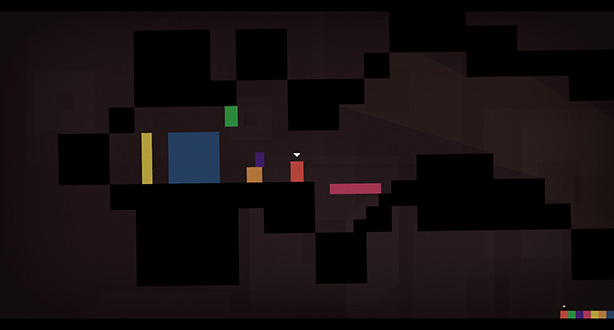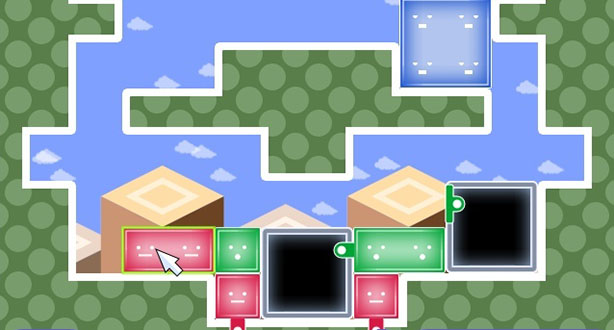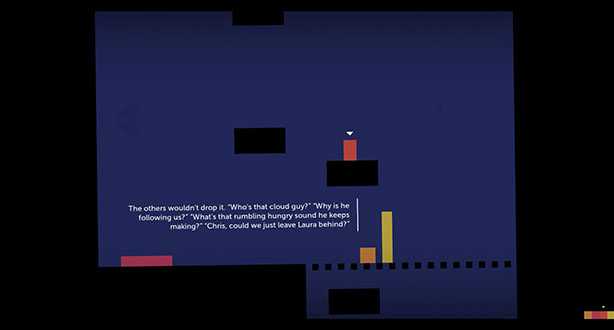
Thomas Was Alone is a great video game. It’s a great video game because it concentrates heavily on areas that developers often pay little attention to, then mostly ignores content we’d usually expect to be at the forefront. It trades character design and incredible spectacle for character depth and incredible writing.
I’m sort of making it sound like Jazz: "Thomas Was Alone’s about the notes he’s not playing, maaaaan."
It’s not perfect, though. There’s an inescapable feeling you’ll have while playing that, although you’re being asked to figure out how to traverse the environment, there’s never a Eureka! moment that accompanies solving a great puzzle. You’ll never feel like you’ve been struggling for a while then suddenly everything clicks together. You just sort of understand what you’re being asked and then you do it. Then you do another thing.

This wouldn’t be a problem if it were simply a bog-standard, bare-bones platformer that leaned mostly on the story and design, but it’s not, it's a game that's actively built around making the player figure out the apparently intricate interrelationship of the game's characters and the environment they have to traverse.
It asks a gradual understanding of how the eponymous Thomas and his rectangular chums interplay with each other through whatever abilities are unique to them. The character Claire can float in water so you’ll pile everyone on top of her to ferry them across. Other characters use Laura like a trampoline and so on. With over half a dozen different characters, this sounds like it should make for a fun challenge, working out who should do what. In reality, though, that added intelligence is almost a negative thing.

By creating extra complexity, the expectation is that the game will use this to provide a greater challenge. Unfortunately, it doesn’t make good on that. Almost without fail, you’ll see the solution to each level the moment you clap eyes on it. The task of completion is then simply one of joining the dots. In other words, it isn't a puzzle.
So what went wrong? The game gives you a task and asks you to complete it. What’s getting in the way of it being puzzling? Ironically, it's the sheer number of characters and they're fixed functions that actually creates the problem. Knowing that certain characters can only do certain things immediately telegraphs to the player that they’re going to be the one required in any given situation. High wall in the way? Get John involved. Particularly low ceiling? Chris is you're man. Other factors play a part too, such as the level design that always makes it a little too clear who and what can go where. Going too much the other way - making the level totally freeform - would undoubtedly flip the problem on its head, making things too difficult, but a nudge in that direction would definitely help.

There’s a free game you can download from here (http://www.freeindiegam.es/2013/01/jelly-no-puzzle-qrostar/). It’s called Jelly No Puzzle. It’s deceptively simple. You can move blocks either left or right, if they touch another block the same colour they fuse together. The devious thing is that because of the highly restricted movement any action you make usually carries massive permanence and commitment. You’ll probably try around a hundred combinations in every level.
In a lot of ways Thomas is similar, not least because they’re both about controlling rectangles: all you’re trying to do is get something from one place to another, but while in Thomas the path is immediately clear, Jelly No Puzzle requires mental agony and constant adjustments in technique. That’s what Thomas Was Alone is missing. It is the puzzler without puzzlement.

As with Ed's recent deconstruction of Bioshock Infinite, the conclusion here isn't that you should avoid Thomas Was Alone - far from it. The way the game tells the story of its rectangular protagonists is utterly charming, and the drip feed of that story throughout the levels keeps you from getting bored while joining those dots. It's just that as with Infinite, there's a real sense that the game could have been so much better had the developer(s) concentrated just a little more on the actual gameplay.
Following its PC and Xbox launches last year, Thomas Was Alone has just been released on the PS3 and Vita with new levels, a new character and a commentary from its maker Mike Bithell. Perhaps not enough reason to buy it again but certainly even more reason to pick it up if you missed it first time round.
I’m sort of making it sound like Jazz: "Thomas Was Alone’s about the notes he’s not playing, maaaaan."
It’s not perfect, though. There’s an inescapable feeling you’ll have while playing that, although you’re being asked to figure out how to traverse the environment, there’s never a Eureka! moment that accompanies solving a great puzzle. You’ll never feel like you’ve been struggling for a while then suddenly everything clicks together. You just sort of understand what you’re being asked and then you do it. Then you do another thing.

This wouldn’t be a problem if it were simply a bog-standard, bare-bones platformer that leaned mostly on the story and design, but it’s not, it's a game that's actively built around making the player figure out the apparently intricate interrelationship of the game's characters and the environment they have to traverse.
It asks a gradual understanding of how the eponymous Thomas and his rectangular chums interplay with each other through whatever abilities are unique to them. The character Claire can float in water so you’ll pile everyone on top of her to ferry them across. Other characters use Laura like a trampoline and so on. With over half a dozen different characters, this sounds like it should make for a fun challenge, working out who should do what. In reality, though, that added intelligence is almost a negative thing.

By creating extra complexity, the expectation is that the game will use this to provide a greater challenge. Unfortunately, it doesn’t make good on that. Almost without fail, you’ll see the solution to each level the moment you clap eyes on it. The task of completion is then simply one of joining the dots. In other words, it isn't a puzzle.
So what went wrong? The game gives you a task and asks you to complete it. What’s getting in the way of it being puzzling? Ironically, it's the sheer number of characters and they're fixed functions that actually creates the problem. Knowing that certain characters can only do certain things immediately telegraphs to the player that they’re going to be the one required in any given situation. High wall in the way? Get John involved. Particularly low ceiling? Chris is you're man. Other factors play a part too, such as the level design that always makes it a little too clear who and what can go where. Going too much the other way - making the level totally freeform - would undoubtedly flip the problem on its head, making things too difficult, but a nudge in that direction would definitely help.

There’s a free game you can download from here (http://www.freeindiegam.es/2013/01/jelly-no-puzzle-qrostar/). It’s called Jelly No Puzzle. It’s deceptively simple. You can move blocks either left or right, if they touch another block the same colour they fuse together. The devious thing is that because of the highly restricted movement any action you make usually carries massive permanence and commitment. You’ll probably try around a hundred combinations in every level.
In a lot of ways Thomas is similar, not least because they’re both about controlling rectangles: all you’re trying to do is get something from one place to another, but while in Thomas the path is immediately clear, Jelly No Puzzle requires mental agony and constant adjustments in technique. That’s what Thomas Was Alone is missing. It is the puzzler without puzzlement.

As with Ed's recent deconstruction of Bioshock Infinite, the conclusion here isn't that you should avoid Thomas Was Alone - far from it. The way the game tells the story of its rectangular protagonists is utterly charming, and the drip feed of that story throughout the levels keeps you from getting bored while joining those dots. It's just that as with Infinite, there's a real sense that the game could have been so much better had the developer(s) concentrated just a little more on the actual gameplay.
Following its PC and Xbox launches last year, Thomas Was Alone has just been released on the PS3 and Vita with new levels, a new character and a commentary from its maker Mike Bithell. Perhaps not enough reason to buy it again but certainly even more reason to pick it up if you missed it first time round.

MSI MPG Velox 100R Chassis Review
October 14 2021 | 15:04









Want to comment? Please log in.